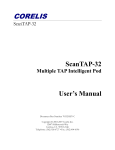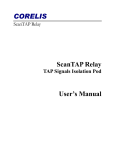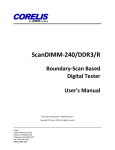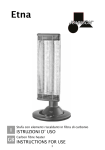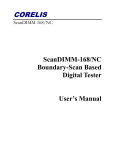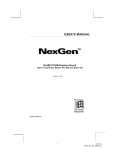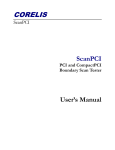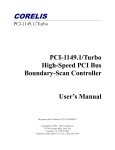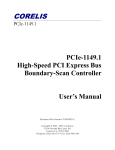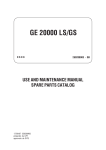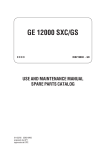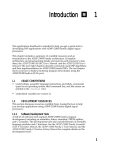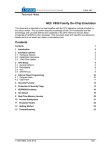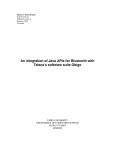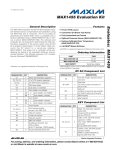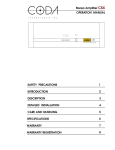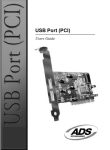Download PCI-1149.1 Boundary
Transcript
PCI-1149.1 Boundary-Scan Controller Features • Half-Slot IEEE-1149.1 Boundary Scan (JTAG) compatible PCI card. • 32 bit PCI bus interface, buffered with two FIFOs to support high data transfer rates. • Supports four independent JTAG ports. One port can be configured as differential or single-ended • JTAG ports and parallel I/O are programmable from 2.0 to 3.4V and are 5V compatible • User programmable test clocks (TCK) with speeds up to 25 MHz • Internal or external scan test clock source • 16 inputs and 16 outputs of programmable parallel I/O • External freeze input to asynchronously enable or disable the TCK • • • Scan Function Library software for Windows 95/NT Plug and play Windows 95/NT device drivers Built-in self-test features Overview Block Diagram The PCI-1149.1 is a sophisticated test controller that can be used in the testing of devices, boards, or systems compliant with the IEEE-1149.1 standard. Using 2 Parallel/Serial converter devices, this PCI bus tester supports up to four independent Boundary-Scan chains. 16 parallel inputs and 16 parallel outputs including two open collector drivers are provided to test or control non-boundary-scan logic of the unit under test. Software controlled voltage translating logic allows the PCI-1149.1 to be used to test low-voltage systems. The PCI-1149.1 contains several performance enhancing functional sections aimed at increasing test vector throughput. A functional block diagram of the PCI-1149.1 is shown in Figure 1. A set of software drivers written in C is supplied with the tester card to allow the end user to create powerful test programs that are tailored to his or her needs. Key functional elements are the dual Test Access Port (TAP) controllers that are fed by two FIFOs, one for receive data and one for transmit data. This provides a high data rate to and from the PCI bus, regardless of actual test clock speeds. All functions of the PCI-1149.1 are controlled by a state machine that contains status and control registers that can be accessed through the PCI bus. Programmable Clocks The PCI-1149.1 TCK outputs to the IEEE Standard 1149.1 compatible Connector Connector JTAG Connector Port A 8 Parallel Outputs Port B 8 Parallel Outputs Port B 8 Parallel Inputs Port B 8 Parallel Inputs Target Presence Detection Capabilies JTAG Bus 1 JTAG Bus 2 TAP Controller • FIFO JTAG Bus 3 JTAG Bus 4 TAP Controller FIFO • Control/ Status Registers Progmble Clock Generator PCI Interface RS-422 Figure 1. PCI-1149.1 Block Diagram target system are programmable under software control. A wide range of TCK frequencies can be achieved by using the on-board TCK generation circuitry. The user is given the ability to select one of three on-board oscillators from which to base the TCK output. The user can then modify this frequency using the on-board divider circuitry to select the desired frequency. Should it become necessary to use a TCK frequency other than one that can be supplied by the on-board circuitry, the user is given the option of generating the TCK outputs to the target system from an externally supplied clock or replacing one of the on-board oscillators. The maximum clock speed is 25 MHz. In order to compensate for cable and circuit time delays however, the maximum clock rate needs to be reduced to 15-20 MHz. Adjustable Low Voltage Outputs The voltage level of the parallel I/O and the 4 TAP interfaces is software programmable and can be set to any voltage between 2.0V and 3.4V in increments of 0.05V. These interfaces are 5V compatible and 5V tolerant at all programmed levels. differential signals on one of its four TAPS. The RS-422 option is selected under software control by writing to the appropriate register. This allows the boundary-scan tester to be located at a greater distance from the unit under test than would otherwise be possible. Parallel Input/Output Ports The PCI-1149.1 contains 16 parallel inputs and 16 parallel outputs. The input and output signals are organized into two 8 bit parallel ports. The parallel input and output ports are accessible from the host computer by reading or writing the appropriate register. The 16 parallel outputs are driven by D-latches and the outputs can be put into a high impedance state by writing to a register. The input and output ports can be used to control and sense various functions in the target system which cannot be controlled or observed through boundary-scan operations. These ports are useful for testing of target systems that incorporate components that are not compliant to IEEE Standard 1149.1. As an alternative to using one of the ports, two open collector outputs are available and are controlled by writing to a register. Open collector signals are often needed to drive reset and emulation signals. Differential Inputs/ Outputs The PCI-1149.1 has the ability to drive and receive RS-422 compatible The PCI-1149.1 has a pin (T_OFF*) on the JTAG interface connector that can be used to detect the presence of the target board. The state of the T_OFF* signal can be monitored by reading bit 0 of Input Port A. When using this feature, the T_OFF* signal should be connected through a pull-up to target power, so when power is on, a logic high will be sensed on this signal. This pin has no other effect on the operation of the board. Built-in Self-Test The PCI-1149.1 has a built-in self-test capability. Logic has been provided at the JTAG connector to read back, synchronously with TCK, data shifted out on TMS and TDO for each of the TAPs. Similarly, logic has been provided to drive each of the TDIs at the TAP interface. In this way the TAPs can be fully tested PCI Bus Interface The PCI-1149.1 is a single-slot, single fucntion 5V/32 bit 33 MHz PCI device completely compliant with Revision 2.1 of the PCI Bus Specification. Scan Function "C" Library Software drivers (Scan Function Library) and a self-test program are provided with the PCI-1149.1 card. The software is coded in ‘C’ and is provided as a 32 bit DLL for Windows NT or Windows 95. The software drivers provide the user with the functions that are necessary to operate the JTAG ports and to send JTAG instructions and data to the target system. The user can incorporate the drivers in his own application software and only code the higher level test procedures. The self-test software sends JTAG instruction and data words to the onboard Boundary-scanned ICs. This code is the actual ‘C’ language code for the executable program TEST.EXE included on the disk. The Scan Function Librar y (SFL) provided can be classified into two categories: • Scanning • Utility/Low-level access The Scanning functions provide a higher level access to the operation of the PCI-1149.1 Board. The table below lists all the SFL routines: circulate_dr() This function starts by flushing out data from selected target’s Data Register (DR) by scanning in the selected bit length + 16 zeros. Then the function will scan the flushed out data back into the target’s DR. hard_reset() This function will perform a hard reset of all the board’s functions. The TCK generators are set to their lowest speed, the TAP controllers are reset and their outputs enabled, the FIFOs are reset, TRST* is pulsed low then high for all TAPs, the parallel outputs are enabled, the TMS is reset, and the self-test features are disabled. RS-422 is selected or not selected and the voltage level of the JTAG and I/O interfaces is set. move_to_state() Transitions the target JTAG device’s state machine to the desired final stable state. read_io() This function reads the input from the selected 8-bit input port. scan_dr() Scans data, from a specified array, out the PCI-1149.1 card and into the target JTAG device’s Data Register (DR). Data that is scanned out of the target JTAG device’s Data Register (DR) into the PCI-1149.1 card during the operation is stored in a specified array. The first bit scanned out is the LSB of the output array’s first member. The first bit scanned in is stored in the LSB of the input array’s first member. Following the scan operation, the device’s JTAG state machine is left in the Run-Test/ Idle state. scan_dr_turbo() Scans data, from a specified array, out the PCI-1149.1 card into the target JTAG device’s Data Register (DR) using hardware acceleration. Most effective for data arrays larger than 512 bytes. Data that is scanned out of the target JTAG device’s Data Register (DR) into the PCI-1149.1 card during the operation is stored in a specified array. The first bit scanned out is the LSB of the output array’s first member. The first bit scanned in is stored in the LSB of the input array’s first member. Following the scan operation, the device’s JTAG state machine is left in the Run-Test/Idle state. scan_ir() Scans data, from a specified array, out the PCI-1149.1 card into the target JTAG device’s Instruction Register (IR). Data that is scanned out of the target JTAG device’s Instruction Register (IR) into the PCI-1149.1 card during the operation is stored in a specified array. The first bit scanned out is the LSB of the output array’s first member. The first bit scanned in is stored in the LSB of the input array’s first member. Following the scan operation, the device’s JTAG state machine is left in the Run-Test/ Idle state. scan_ir_turbo() Scans data, from a specified array, out the PCI-1149.1 card into the target JTAG device’s Instruction Register (IR) using hardware acceleration. Most effective for data arrays larger than 512 bytes. Data that is scanned out of the target JTAG device’s Instr uction Register (IR) into the PCI-1149.1 card during the operation is stored in a specified array. The first bit scanned out is the LSB of the output array’s first member. The first bit scanned in is stored in the LSB of the input array’s first member. Following the scan operation, the device’s JTAG state machine is left in the Run-Test/Idle state. scan_NxCLK() Scan clocks through the interface without toggling TMS or TDO. scan_to_pause_dr() Scans data, from a specified array, out the PCI-1149.1 card into the target JTAG device’s Data Register (DR). Data that is scanned out of the target JTAG device’s Data Register (DR) into the PCI-1149.1 card during the operation is stored in a specified array. The first bit scanned out is the LSB of the output array’s first member. The first bit scanned in is stored in the LSB of the input array’s first member. Following the scan operation, the device’s JTAG state machine is left in the Pause-DR state. scan_to_pause_ir() Scans data, from a specified array, out the PCI-1149.1 card into the target JTAG device’s Instruction Register (IR). Data that is scanned out of the target JTAG device’s Instruction Register (IR) into the PCI-1149.1 card during the operation is stored in a specified array. The first bit scanned out is the LSB of the output array’s first member. The first bit scanned in is stored in the LSB of the input array’s first member. Following the scan operation, the device’s JTAG state machine is left in the Pause-IR state. set_scan_clk() This function will set the TCK clock speed for the specified TAP pair. Note that the TCK is only present during tms_reset(), move_to_state() and scan operations. set_io() This function sets the output levels of the selected 8-bit output port. The programmable voltage levels are set by the hard_reset() function. set_oc_output() This function sets the open collector output level, of the selected bit, on output port A. test() This function is a simple test of the application program’s ability to execute library function calls. It simply returns the integer you passed in when called correctly. tms_reset() Hold TMS signal high for 5 TCKS to put device’s JTAG state machine into Test-Logic Reset state. trst_reset() Pulse the TRST* signal low then high on the selected TAP to reset those JTAG devices that support the TRST* signal. Places the TAP in Test-Logic Reset state. I/O Connectors Input Port Connector (P1) 34 pin IDC Compatible with SCANPLUS™ Family of Products The PCI-1149.1 is both hardware and software compatible with the complete SCANPLUS™ family of IEEE-1149.1 and IEEE-P1149.5 test products. Consequently, test programs developed for other Corelis tester platforms will run on the PCI-1149.1 and vice-versa. 8/16/32 bit Interrupts INTA# (optional) 4 Maximum TCK frequency: 25 MHz Parallel and TAP DC Characteristics User’s Programmable I/O Voltage (Vcc) = 2.7-3.4V MAX UNIT 2.0 3.4 V 2.0 V V = 2.7-3.4V 0.8 V = 2.7V -12 mA = 3.0V -24 mA = 2.7V 12 mA 24 mA CC High Level Output Current I V MIN CC IL OH V CC V CC I Low Level Output Current OL (3M part no. 2534-6002UB or equivalent) JTAG Connector (P3) 40 pin IDC Operating Environment Temperature: 0°C to 55°C IEEE-1149.1 Number of TAP Controllers: V Low Level Input Voltage 34 pin IDC Power Requirements (From host expansion bus) 5V @1.5A maximum PCI Interface Bus Width IH Output Port Connector (3M part no. 3432-5203 or equivalent) Specifications V High Level Input Voltage (3M part no. 2534-6002UB or equivalent) V Relative Humidity: 10% to 90%, non-condensing Storage Environment Temperature: -40°C to 85°C Relative Humidity: 0% to 100%, non-condensing Supplied With the Module • PCI-1149.1 Boundary-Scan Controller Card • Scan Function Library and self-test software disk • User’s Manual. CC V = 3.0 V CC V OH I = -100mA OH V =2.0-3.4V CC (Hi-level I = -12mA Output Voltage) OH V -0.2 V CC V = 2.7V 2.2 V 2.4 V 2.2 V CC V = 3.0V CC I = -24mA OH V OL I V = 3.0V CC = 100mA OL I = 12 mA (Low-level OL Output Voltage) I = 24 mA OL V = 2.0-3.4V 0.2 V 0.4 V 0.55 V CC V =2.7V CC V = 3.0V CC Physical Board Outline Dimensions (PCB): 3.8" x 5.5" (PCI short card) Windows® and WindowsNT® are trademarks of Microsoft Inc. ScanPlus™ is a trademark of Corelis Inc. © Copyright 1998 by Corelis Inc. All rights reserved. Permission granted to make copies for free distribution. 12607 Hiddencreek Way Cerritos, California 90703 Tel: (562) 926-6727, Fax: (562) 404-6196 [email protected] http://www.corelis.com CORELIS INC., reserves the right to make changes in design or specification at any time without notice.




